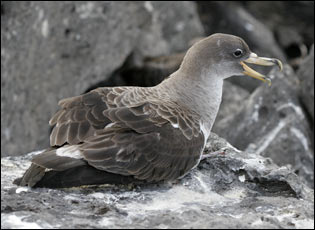
Cory's Shearwater, Selvagem Grande
Photo: Bosse Carlsson
Photo: Bosse Carlsson
The Selvagens
are a small, isolated, almost uninhabited (except for the wardens on Selvagem
Grande) and seldom visited archipelago lying between Madeira and the Canary
Islands. As with Madeira, they are Portuguese territory (their Portuguese name,
Ilhas Selvagens, actually means 'wild islands') and, as with all of the
Macaronesian Islands, they are volcanic in origin.
The
archipelago consists of two groups and has a total area of 283 hectares (2.83
km²). The northeast group comprises Selvagem Grande and two smaller islets,
Palheiro de Terra and Palheiro do Mar. The southwest group comprises Selvagem
Pequena (30 ha) and Ilhéu de Fora (8 ha) as well as numerous smaller islets,
including the Alto, Comprido and Redondo Islets, and also the tiny group of the
Norte Islets. These islets as well as several small rocky reefs surrounds the
southwest group, which makes it difficult to land to any of these islands. The
Selvagem Grande and Selvagem Pequena islands lie 10 nautical miles (15 km)
apart.
On Selvagem
Grande there is a permanent field station manned by two wardens year-round,
while Selvagem Pequena is manned by two wardens between May and October. These
are the only human inhabitants on the islands during the whole year. The
wardens are replaced every third week by the Portuguese Navy.
The islands
are too small and too low to create a proper balanced climate of their own.
Therefore they are very dry (recalling much of the Desertas Islands south-east
of Madeira) and the temperature are higher than on Madeira. There is a cistern
with capacity of 113 metric tons of water, which fills from the rain and was
recuperated in 1967. There is a second cistern, built more recently by the
warden's house, with a capacity of some 80 metric tons. Occasionally winds from
SW bring exceptionally heavy rainfall, on the other hand dry winds from the
east carry dust and many migrant birds from Africa, especially during the
migratory season. To fill the cisterns it is necessary to have heavy rain and
it has been known not to rain for three consecutive years!
Selvagem Grande
This is the
largest island in the archipelago and has an area of 2,45 km². It is pentagon
shape and has steep cliffs, 70-90 metres high above sea-level. The interior is
flat, on average about 100 metres. Only three summits, remnants of former
volcanic cones, overlook the plateau with a maximum height of 163 metres (Pico
da Atalaia).
Since the
15th century goats live on the island, brought there as living supplies for
sailors. Later rabbits and mice (probably accidentally) were introduced.
Fortunately the goats disappeared at the end of the 19th century due to
hunting, but rabbits and mice only disappeared in 2003 by an eradication
programme developed by the Natural Park.
Several
hundred years ago the Shrub Tobacco from South America was imported/introduced
for firewood and spread rapidly. This plant is also included in a separate
eradication programme, organized by the Natural Park.
Selvagem Pequena
Much smaller
than Selvagem Grande (0.3 km²) and has a much more rugged and rockier coast.
Pico Veado is the highest point at 49 metres, the rest of the island is rather
flat island (only 5-10 metres above sea level). Selvagem Pequena and Ilhéu de
Fora were spared the introduction of rabbits and goats, which means they still
have the most original and untouched vegetation of all Macaronesian islands.
Therefore the vegetation here is more varied than on Selvagem Grande.
Ilhéu de Fora
The smallest
(0,081 km²) of the three larger islands in the archipelago and very similar to
Pequena in habitat. It too, is covered with limy sands on its flat plateau,
which rises only up to 18 metres above sea-level.
Discovery and its protection today
The first
recorded official discovery of the Selvagens dates from 1438, when Diogo Gomes
de Sintra sighted them when returning to Portugal from Guinea, nineteen years
after the discovery of Madeira. At that time, the Portuguese discoverers
consistently expanded the horizons of European knowledge.
The Selvagens
were awarded the Diploma of the Council of Europe, a diploma which it still
holds. In 2003 these islands were selected to be the national candidates for
the UNESCO World Heritage List. They withdrew their application so that a
formal application could be made at a later date in more detail.
As a matter
of curiosity the famous Jacques-Yves Cousteau once said he found the cleanest
waters in the world around Selvagens Islands.

